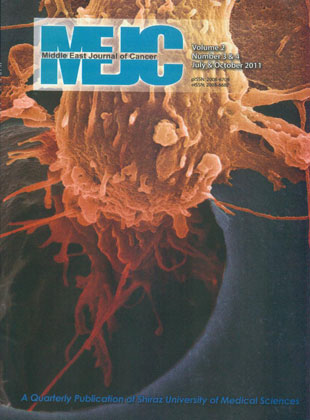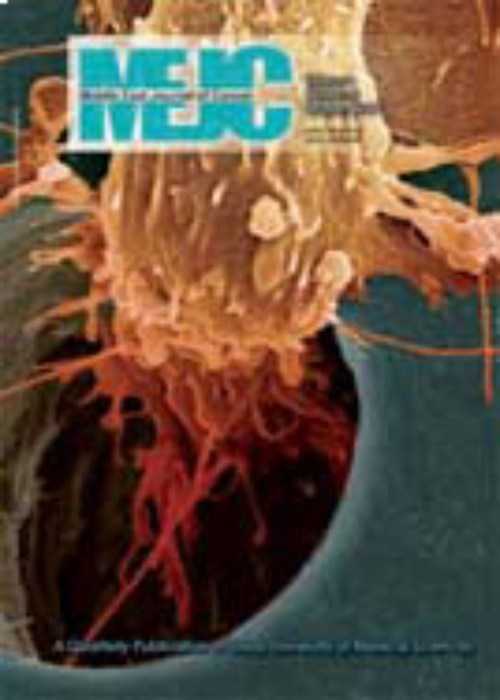فهرست مطالب

Middle East Journal of Cancer
Volume:2 Issue: 3, Jul & Oct 2011
- تاریخ انتشار: 1391/03/21
- تعداد عناوین: 9
-
-
Page 93BackgroundThe brain is a rare site of metastases from ovarian cancer. Limited data are available on prognostic factors, standard treatment, and survival. Knowledge of clinical prognostic factors would help the management of patients with brain metastases. The aim of this study is to evaluate the impact of clinical factors and treatment modalities on survival in patients with brain metastases from ovarian cancer.MethodsWe performed a retrospective analysis of an electronic database of patients with brain metastases from ovarian primary treated at Clatterbridge Centre for Oncology.ResultsA total of 20 patients with brain metastases from an ovarian primary were treated from April 2001-February 2011. Median age at occurrence of brain metastases was 55 years. The median time from primary diagnosis to occurrence of brain metastases was 23 months. Median overall survival from diagnosis of brain metastases was 9 months. Poor ECOG performance status, platinum resistance, and advanced FIGO staging were the most significant adverse variables identified. Median survival was 13 months for platinum sensitive patients and 6 months for platinum resistant patients.ConclusionPlatinum sensitivity is an important prognostic factor in patients with brain metastases from an ovarian primary tumor. Multimodal therapy that consists of surgery, radiotherapy, and chemotherapy should be considered where feasible.
-
Page 99BackgroundSentinel lymph node biopsy is used as an accurate staging procedure to detect early breast cancer. Several studies have documented that sentinel lymph node biopsy can accurately determine the status of axillary nodes. Sentinel node biopsy offers the advantage of accurately staging the axilla and eliminating the need for a full axillary dissection for patients who have a negative sentinel node. The aim of this study is to determine the predictors of non-sentinel lymph node metastasis by sentinel node biopsy.MethodsIn this study, all patients (n=88) who underwent sentinel node biopsy for invasive breast cancer from June 2005 to June 2010 in Shahid Faghihi Hospital, Shiraz, Iran were enrolled. We reviewed the medical files of patients and their tumor characteristics. Statistical analysis was performed to determine whether any of these characteristics alone could accurately predict the remaining non-sentinel node status.SPSS statistical package was used.ResultsThe mean age of the patients was 46.1 years. Tumor size was 2.73 cm. Of the 88 patients who underwent complete axillary node dissection, 34 had metastases in the non-sentinel nodes, with a mean of 4 positive non-sentinel nodes in each patient. Statistically, neither the patient’s age nor the clinicopathological features of the tumor were significantly associated with non-sentinel node metastases (all: P>0.05).ConclusionOur study shows that neither the primary tumor characteristics nor the size of metastasis in the sentinel lymph node can predict the status of non-sentinel nodes. However, further investigation is necessary. Complete axillary node dissection should remain the most appropriate management for patients with positive sentinel lymph nodes.
-
Page 105BackgroundEsophageal cancer is a major clinical problem that has a generally poor prognosis. As a result, there has been interest in combining surgery with neoadjuvant chemotherapy in an attempt to improve clinical outcomes. Evidence for clinical benefit from preoperative chemotherapy exists but it is not clear which patients (stage, tumor location, and histology) will benefit the most from this preoperativetreatment.MethodsThis study retrospectively analyzed the outcome of 71 patients with operable esophageal carcinoma treated at Northamptonshire Oncology Centre, UK from January 2001 until July 2008. Patients were treated with two cycles of neoadjuvant chemotherapy followed by surgery. Data were analyzed by Kaplan-Meier plots, Cox regression modeling and chi-squared test.ResultsMedian patient’s age was 64 years. Male patients represented 83% of the cases. Of patients, 63% had an ECOG performance status of 1. Surgical resection was done for 63 (88.7%) patients. Two year overall survival in this cohort was 5.6%.Univariate analysis identified only surgical resection to be associated with better prognosis (P<0.0001). Multivariate analysis identified surgical resection (P<0.0001) and pathology type (P=0.007) to be the significant independent prognostic factors for survival.ConclusionIn this retrospective study, survival data for operable esophageal cancer is poor despite the use of neoadjuvant chemotherapy. Lack of a dedicated upper gastrointestinal surgeon and unavailability of PET scan staging during the study period might have attributed to the poor outcome.
-
Page 113BackgroundThe intent of this study was to audit and evaluate the information content of pathology reports of resected gastric cancer specimens in Yazd, Iran.MethodsAll gastric cancer reports of patients from the histopathology laboratories in Yazd over a six-year period who referred for adjuvant radiation therapy to Shahid Ramazanzadeh Radiation Oncology Center were evaluated for their information content. A standard was adapted from the Nationwide guideline, version 1.0 of Netherland that explained the minimum data set for gastric cancer pathology reports that included: histologic type, grade, T stage, N stage, distance between the tumor andnearest resection margin, tumor size and, location, as well as perineural, lymphatic and vascular invasion.ResultsWe audited 56 reports. Unfortunately, none of the reports were adequate.Tumor subtype was not reported in 80.4% of patients, grade in 16.1%, T stage in 8.9%,N stage in 26.8%, margin in 57.1%, tumor size in 10.7%, and location in 41.1%.ConclusionThis audit showed a need to improve the information content of gastric cancer pathology reports. The widespread implementation of template proforma reporting is proposed as the most effective way of achieving this goal. On the other hand,improving surgical techniques, adequate lymph node resection and tumor resection with adequate margins is necessary.
-
Page 117BackgroundThe incidence of thyroid cancer has varied from 2 per 100,000 in Europe to 21 per 100,000 in the Hawaiian Chinese population and is 2-3 fold more common in females. Middle East Cancer Consortium figures from 1996-2001 have recorded different age standardized incidence rates that ranged from 2 per 100,000 in Egypt to 7.5 per 100,000 among Israeli Jews. In Jordan the age standardized incidence rate of thyroid cancer was 3 per 100,000 during that period. This study aimed to define the incidence of thyroid cancer in Jordan and to explore the epidemiological characteristics of patients and tumors.MethodsThis was a descriptive epidemiological study that utilized data reported to the Jordan Cancer Registry during 1996-2008.ResultsThe incidence rate in Jordan varied during the period from 1996 to 2008;however the recorded rate (2.6 per 100,000) in 1996 and 2008 was similar. The incidence rate was higher among Jordanian females. Age specific incidence rate and age standardized incidence rate were parallel during the study period with no peaks.The most common morphological type of thyroid cancer in Jordan was papillary carcinoma (76%). The average annual incidence during the study period was highest (3.3 per 100,000) in Amman and (2.2 per 100,000) in Jarash governorates.ConclusionThe results of our study are consistent with international studies. The incidence of thyroid cancer in Jordan is not high when compared with other countries.The high incidence of thyroid cancer in Amman and Jarash governorates in comparison to the incidence in other governorates needs further assessment.
-
Page 125Malignant lymphoma may occur in the oral cavity and oropharynx, but is most commonly located in Waldeyer's ring, particularly in the palatine and lingual tonsil. The occurrence of malignant lymphoma in the tongue is very rare. Clinical features are nonspecific ulcerative lesions that do not heal. In the literature, the majority of cases are non-Hodgkin’s lymphoma, diffuse large B cell type; however T-cell phenotype also may occur. We describe a 60-year-old man who presented with an ulcerative mass in the left lateral aspect of his tongue, unresponsive to medical therapy. After tissue biopsy, histopathological and immunohistochemical analyses confirmed a diagnosis of non-Hodgkin’s lymphoma, diffuse large B cell type..
-
Page 129Adenoid cystic carcinoma of the lung is a relatively rare, slow growing lung neoplasm. Metastases outside the lung are uncommon. Herein, we have reported the case of a patient who presented with a large mass in the right lower lobe of her lung. Bronchial biopsy revealed features suggestive of adenoid cystic carcinoma of the lung with a predominant cribriform architecture. CT abdomen showed features of bilateral renal and liver metastases, but no adrenal metastases.
-
Page 135Esophageal cancer is the ninth most common malignancy.The incidence of esophageal cancer varies greatly among regions of the world and occurs at a high frequency in Asia and northern Iran.We report the case of an 80-year-old man with esophageal squamous cell carcinoma who initially presented with a metastatic scalp lesion. Esophagoscopy was performed and a lesion was located in the mid-portion of the esophagus. Pathological and immunohistochemical studies favored the diagnosis of a metastatic scalp lesion.
-
Page 139Carcinoid tumors of the bile duct are rare. Despite cholangiocarcinoma, they grow more slowly and generally occur in younger patients and females. These tumors have a better prognosis and more disease-free survival. We present the case of a 25-yearold male with common bile duct (CBD) carcinoid tumor misdiagnosed as cholangiocarcinoma.


